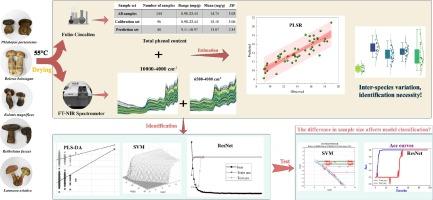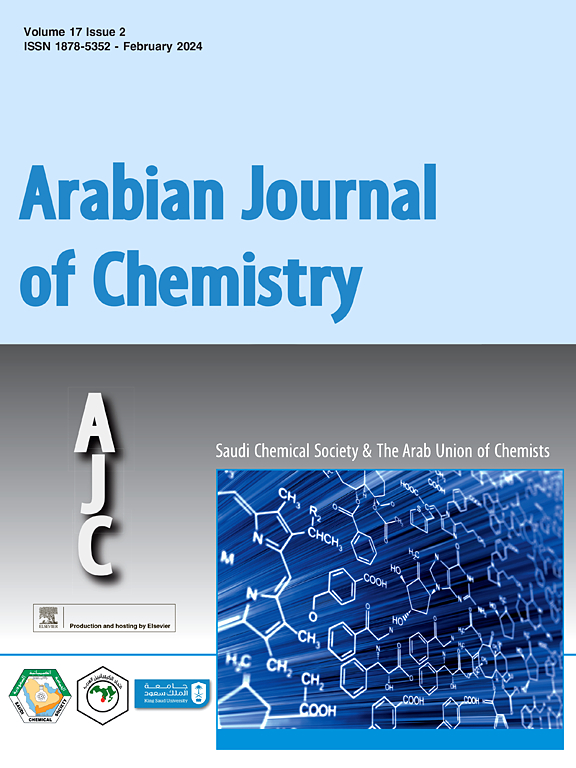利用傅立叶变换近红外光谱仪快速、非侵入式地估算干制野生食用牛肝菌中的总酚含量并鉴定其种类
IF 5.2
2区 化学
Q2 CHEMISTRY, MULTIDISCIPLINARY
引用次数: 0
摘要
干野生食用菌市场的特点是质量参差不齐和品种杂乱无章,这引起了人们的关注。研究人员调查了使用傅立叶变换近红外光谱(FT-NIR)和化学计量学方法预测干牛肝菌的总酚含量和识别物种的可行性。在测定总酚含量、获取傅立叶变换近红外光谱和二维相关光谱(2DCOS)图像时,利用了五种常见的干食用牛肝菌(n = 144)。结果表明,偏最小二乘回归(PLSR)结合傅立叶变换近红外光谱仪可预测牛肝菌干的总酚含量,最佳预测决定系数(R2p)= 0.79。偏最小二乘判别分析(PLS-DA)模型准确地识别出了孔雀草,马修斯相关系数(MCC)、精确度(PRC)、灵敏度(SEN)和特异度(SPE)均为1。在测试集中,支持向量机(SVM)模型在识别加工食用牛肝菌(Lanmaoa asiatica)方面表现最佳,准确率达到 100%。2DCOS 图像与残差卷积神经网络(ResNet)模型相结合,证明了傅立叶变换近红外全光谱带(10,000-4,000 cm-1)和特征光谱带(6,500-4,000 cm-1)用于牛肝菌物种鉴定的可行性。该方法适用于组间样本量一致或不一致的情况,训练集和测试集的准确度均为 1.00。这项研究是一种快速、非侵入性和方便的方法,可用于实时评估市场上食用牛肝菌干的质量。本文章由计算机程序翻译,如有差异,请以英文原文为准。

Rapid and non-invasive estimation of total phenol content and species identification in dried wild edible bolete using FT-NIR spectroscopy
The market for dried wild edible mushrooms is characterized by quality discrepancies and species disorganization, which are a matter of concern. The feasibility of using fourier transform near-infrared (FT-NIR) spectroscopy with chemometrics to predict the total phenol content and identify species was investigated in dried bolete. For the determination of total phenolic content, FT-NIR spectral acquisition, and two-dimensional correlation spectroscopy (2DCOS) image acquisition, five common species of dried edible bolete (n = 144) were utilized. The results showed that partial least squares regression (PLSR) combined with Fourier transform near-infrared spectroscopy could predict the total phenol content of dried boletes, with the best prediction coefficient of determination (R2p) = 0.79. The partial least squares discriminant analysis (PLS-DA) model accurately identified Phlebopus portentosus, with Matthews correlation coefficient (MCC), Precision (PRC), Sensitivity (SEN), and Specificity (SPE) all being 1. The support vector machines (SVM) model is performed optimally to identify processing edible bolete (Lanmaoa asiatica) with an accuracy of 100 % in the test set. 2DCOS images combined with the residual convolutional neural networks (ResNet) model demonstrated the feasibility of FT-NIR full spectral bands (10,000–4,000 cm−1) and characteristic spectral bands (6,500–4,000 cm−1) for species identification of boletes. The method applies to the case of consistent or inconsistent sample sizes between groups, with an accuracy of 1.00 for both the training and test sets. The study serves as a rapid, non-invasive, and convenient method for real-time evaluation of the quality of dried edible bolete in the market.
求助全文
通过发布文献求助,成功后即可免费获取论文全文。
去求助
来源期刊

Arabian Journal of Chemistry
CHEMISTRY, MULTIDISCIPLINARY-
CiteScore
10.80
自引率
3.30%
发文量
763
审稿时长
63 days
期刊介绍:
The Arabian Journal of Chemistry is an English language, peer-reviewed scholarly publication in the area of chemistry. The Arabian Journal of Chemistry publishes original papers, reviews and short reports on, but not limited to: inorganic, physical, organic, analytical and biochemistry.
The Arabian Journal of Chemistry is issued by the Arab Union of Chemists and is published by King Saud University together with the Saudi Chemical Society in collaboration with Elsevier and is edited by an international group of eminent researchers.
 求助内容:
求助内容: 应助结果提醒方式:
应助结果提醒方式:


